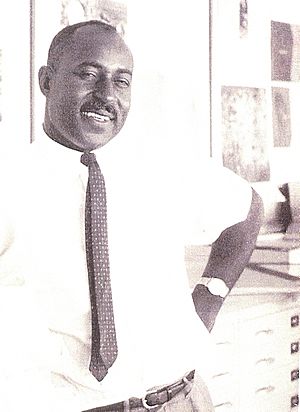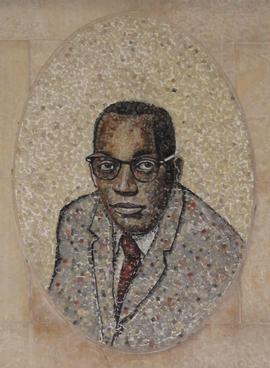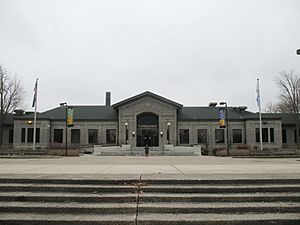Thomas Miller (visual artist) facts for kids
Quick facts for kids
Thomas Miller
|
|
|---|---|

Thomas Miller at the offices of Morton Goldsholl Associates, c.1958
|
|
| Born | December 24, 1920 |
| Died | July 19, 2012 (aged 91) |
| Nationality | American |
| Education | Ray Vogue School of Art, (now the Ray College of Design) |
| Known for | Oils Watercolors Acrylics Monotype Sculpture Mosaics Fome-Cor Portraiture Commercial Art |
| Movement | Abstract Expressionism Realism Modernism |
| Spouse(s) | Anita Miller |
| Patron(s) | Margaret Taylor-Burroughs Harold Washington Deloris Jordan |
Thomas Miller (December 24, 1920 – July 19, 2012) was a very active graphic designer and visual artist. This means he created art for both companies and for himself. His most famous public artworks are the amazing mosaics of the founders of the DuSable Museum of African American History in Chicago, Illinois. These colorful mosaics are a main feature in the museum's lobby. The building itself has a long history, becoming the DuSable Museum in 1973.
Contents
Thomas Miller's Life Story
Early Years and Education
Thomas Miller was born in Bristol, Virginia, in 1920. He finished high school there in 1937. He then went to Virginia State College, which is now Virginia State University. This college was special because it was the first state-supported four-year school for African Americans.
He graduated in 1941 with a degree in education, focusing on art. After college, he joined the U.S. Army. He became a first sergeant and served during World War II.
Learning About Art
When Thomas was a kid, it was hard for him to formally study art. Black libraries in the South often didn't have the art history books he wanted. But he was determined! He found ways to use libraries that were usually only for white people. There, he discovered the works of Leonardo da Vinci, who became a huge inspiration for him.
After the army, Miller moved to Chicago. He wanted to formally study Commercial art, which is art used for advertising and businesses. He got into the Ray Vogue School of Art. This was not easy for African Americans back then. He and another student were the only Black students there, besides the janitors. The school was well-known for art and fashion design. Miller studied commercial and graphic art there and finished in 1950.
Working as a Professional Artist
Thomas Miller started his career at a small firm in Chicago. Soon after, he joined Morton Goldsholl Associates in 1950. This company was known for being fair and hiring people of all backgrounds, including minorities and women. It was a small but very creative studio.
Joining Goldsholl Associates
Getting a job at Goldsholl was a big step. Miller remembered Morton Goldsholl telling him, "I'm hiring you because I need a designer, not because you're Black." This was a turning point for Miller. It meant he was hired for his talent.
The path to this job wasn't easy. Because of racial barriers, Miller had to leave his wife and two children in Florida. They stayed with his wife's sister while he looked for work where he would be treated equally. He first tried New York City and New Jersey. One company offered him a job but wanted him to work behind a screen so clients wouldn't see him. Miller refused this unfair offer. He then came to Chicago, where he found work and eventually joined Morton Goldsholl. He stayed there for 35 years until he retired.
Creative Work at Goldsholl
Morton Goldsholl Associates was a small but highly respected firm. It became famous around the world for its creative work. They designed logos and packaging for big companies like Motorola, Quaker Oats, and the Peace Corps. They also made animated commercials for brands like Gillette and Hallmark.
Miller helped with many of these projects. He was the main designer for the new look of 7 Up soda in the mid-1970s. He said the idea for the design just came to him. He used circles to show the bubbles in the drink. For this and other projects, he won several awards. He was one of the first African Americans to succeed in the mainstream graphic design world.
Creating Art on His Own
Thomas Miller also created art independently, meaning for himself or for private buyers. This started during World War II when he was in Europe. Art supplies were hard to find, but Miller used whatever he could. He would sketch and paint the beautiful European scenery. People often admired his work and would buy it from him.
After the war, while working at Goldsholl, Miller continued to make his own art. He showed his work at different places. At a show in Hyde Park, he met Margaret Taylor-Burroughs. She was the director of the DuSable Museum. She asked him to create a memorial for the museum's founders. This meeting led to his famous mosaics.
Miller also copied famous artworks for collectors. These copies were always a little different from the originals, maybe in size, color, or with a small added detail. This helped him study the styles of other artists.
Thomas Miller's Artworks
Famous Mosaics
- Founders Mosaics - DuSable Museum of African American History
These mosaics are Thomas Miller's most important work. They show his amazing creativity. Unlike regular mosaics made with glass or ceramic tiles, Miller made these from thousands of pieces of plastic. He took plastic from egg crate light diffusers, colored each piece, and arranged them to create the images. He said, "Anyone can do an oil painting, but to take a face and do it with squares is hard. They have to be turned at an angle to catch the light." The series includes portraits of the museum's founders, Jean Baptiste Point du Sable (who founded Chicago), and former Chicago mayor Harold Washington. There's also a mosaic showing Chicago's history.
Designs for Companies
- Redesign of the branding for 7 Up (1976) - Miller was the chief designer for this project.
- Motorola rebranding (around 1961) - Miller was part of the design team.
- Peace Corps logo (around 1961) - Miller was part of the design team.
- Betty Crocker "Chicken Helper" branding (around 1973) - Miller was part of the design team.
Thomas Miller's Legacy
Thomas Miller passed away peacefully in his sleep in Chicago, Illinois, on July 19, 2012. His art and designs continue to inspire many, especially his famous mosaics at the DuSable Museum. His papers, including photos, designs, and awards, are kept at the University of Illinois at Chicago.



